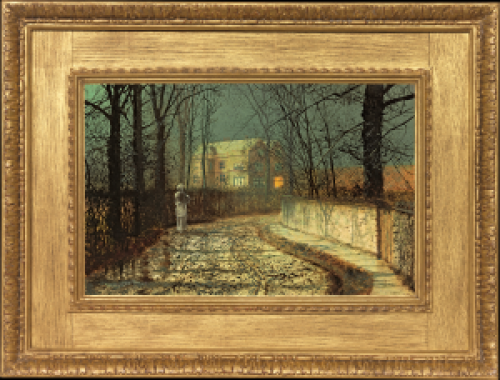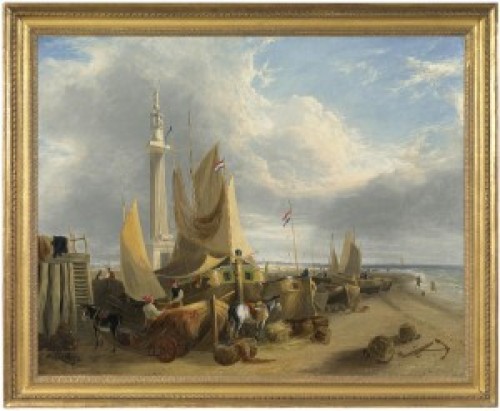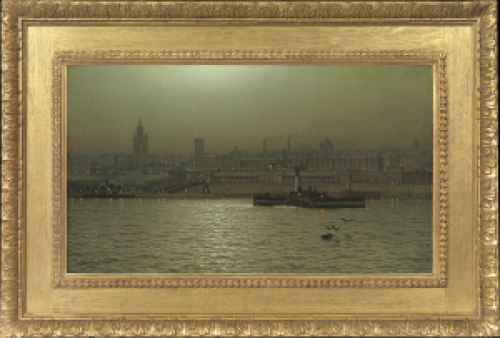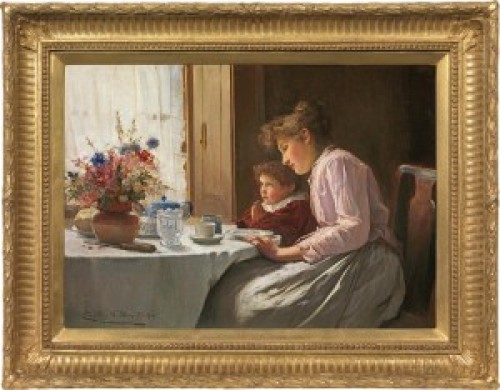GEORGE ELGAR HICKS RBA
Lymington 1824 - 1914 Odiham
Ref: BZ 122
Osier whitening or withy peeling
Signed and dated lower right: G.E. Hicks. 1857
Oil on canvas: 20 x 36 in / 50.8 x 91.4 cm
Frame size: 27 x 43 in / 68.6 x 109.2 cm
In a Victorian style fluted and gilded composition frame
Provenance:
The artist;
G Simms, Bathwick Hill, Bath, purchased from the above for £150
Hahn Gallery, by 1971
Private collection, then by descent
Exhibited:
London, Royal Academy of Arts, Summer Exhibition, 4th May-25th July 1857, no.409, with the subtitle ‘The preparation of the willow for making baskets is carried on in several counties of England during May and part of June’
London, Geffrye Museum, George Elgar Hicks: Painter of Victorian Life, 1st October 1982 – 3rd January 1983; this exhibition then travelled to Southampton Art Gallery, 17th January 1983 – 22nd February 1983, no.16
Literature:
Art Journal, 1st June 1857, p.172
Athenaeum, 23rd May 1857, p.667
Art Journal, 1st April 1872, p.97
Rosemary Treble and Rosamond Allwood, George Elgar Hicks: Painter of Victorian Life, exh cat., Geffrye Museum, London 1982, cat.no. 16, p.21, illus.
Painted in brilliant colours of Pre-Raphaelite intensity with an exceptional refinement of technique and attention to detail, George Elgar Hicks’ Osier whitening was created during what Jeffrey Daniels describes as the ‘most fruitful and creative period of his career, the 1850s and 60s, when he produced that series of scenes from contemporary life that are his chief claim to serious critical attention.’[1]
Writing in the retrospective exhibition catalogue of the artist’s work in 1982-3, Rosamond Allwood relates of the rural industry, ‘During the nineteenth century willow for basket making and thatching was grown in osier beds of up to 100 acres in various parts of the country. Basket making was by this time more than just a local trade…There were different ways of preparing willow, depending on the desired colour of the finished product : brown, buff or white; ‘The brown is dried without being peeled ; the buff is boiled then peeled ; the white is stood out [ie. put back to weather in the mud of the osier bed] and it grows again, then peeled.’ Peeling was done by means of a willow-stripper, or brake, which had iron forks or, as shown here, cleft sticks through which the willow rod is drawn. The osier beds may be seen on the right of the painting, while the peeled willows can be seen standing up to dry in large bundles on the left.’[2]
Allwood goes on to describe the present work as ‘an important link between Hicks’s earlier landscapes and his modern-life paintings of the late 1850s and 1860s. The subject matter and clear colouring give the work an affinity with Gleaning, although the colours are generally softer in the later work, producing a more gentle effect. The horizontal format and arrangement of a number of figures in groups across the canvas anticipate paintings like Dividend Day and The General Post Office. The interest in costume detail runs as a linking thread through all the works.’[3]
Prior to his success with modern urban subjects, such as Dividend Day. Bank of England (The Bank of England Museum) and The General Post Office. One Minute to 6 (Museum of London), both 1859, Hicks depicted idyllic scenes of rural life with the agricultural labourer as hero, such as Haymaking in 1854 (RA 1855) and 1855, and Gleaning, 1855 (RA 1856),[4] which the artist described in his notebooks as, ‘an experiment, painted by glazing on wet white with primitive colours, to get vibration of heat.’[5] Allwood writes, ‘this technique was used by the Pre-Raphaelites from the late 1840s to give their paintings a rich, luminous quality, and was probably learned from William Mulready, who taught at the Royal Academy Schools…It is interesting, but perhaps not too surprising that Hicks was influenced by the Pre-Raphaelites to experiment – he had been at the Royal Academy Schools at the same time as Rossetti, and like all their contemporaries must have been following the fortunes of the Brotherhood with interest.’[6]
Though the formats and compositions are different (Osier Whitening, 1857, is a much larger, more complex work), the entry to both paintings is a seated mother in the left foreground who forms the base of a triangular group with another, standing woman. Hicks presents us with the woman’s back as she feeds her infant, the lines of her beautiful tartan dress echoed in the long strips of willow directing our eyes across the highly detailed and brightly coloured canvas. While looking down and smiling fondly at the seated mother and child, the half stripped willow in the standing woman’s hands curves up and across to a couple working side by side, the picture of youth and vigour. With his left leg forward the man leans towards the brake while his partner, pretty in pink, leans back to admire him, forming the next triangular group echoed in the bunch of willows resting against the brake and the wooden struts supporting it. The tapering branch in the man’s hands arches down and across to the third group in the foreground.
George Elgar Hicks, Haymaking, 1855 George Elgar Hicks, The Barley Harvest, 1859
Oil on canvas: 18 x 14 in Oil on canvas: 17 x 13 in
Private collection, previously with Richard Green Atkinson Art Gallery, Southport
George Elgar Hicks painted a variety of subjects including religious scenes, landscapes and his preferred form of genre scenes. His most famous works were extraordinarily detailed portrayals of Victorian life, reminiscent of the great Victorian novelists Charles Dickens and George Augustus Sala in their narrative intensity and documentary power. Perhaps the best known of these images are General Post Office, one minute to six, Billingsgate Fish Market, Woman's Mission, Changing Homes and Before the magistrates. Later in life, Hicks developed his skill as a portraitist.
The Athenaeum commented upon the significance Hicks’s views of Victorian life would hold for future generations: ‘Mr G E Hicks hit upon a good idea when he resolved to paint for us the scenes which take place at some of the well-known places of business of the City of London...Such pictures, even less well painted than these really are, will be interesting for the future time, and therefore we shall be thankful to get them as creditably executed as [those of Hicks are.]’
Hicks studied for a medical degree at University College, London, before becoming an artist. He studied at Sass’s Academy and the Royal Academy Schools, which he entered in 1844. He won a Silver medal for his studies from the Antique. He exhibited regularly at the Royal Academy from 1848, though many of his works reached their greatest fame through their exhibition at private galleries, which gained enormous prestige in the mid-nineteenth century art world, in particular Henry Wallis’ French Gallery. The vast dissemination of these compelling images in the form of prints, engraved for the print dealer Louis Victor Flatow, ensured the enormous and enduring popularity of the artist.
He married Maria Harriss in 1847 and the marriage produced six children, Georgina, Edward, Frederick, Mary, Rosa Gordon and Annie. Several died in childhood and Hicks lost his wife Maria in 1880. He remarried in 1884 to Anne Ross. He lived most of his life in London and Hampshire.
The work of George Elgar Hicks is represented in the following public collections: Grundy Art Gallery, Blackpool; Bristol Museum & Art Gallery; the Manchester City Art Gallery; National Trust, Wimpole Hall; Southampton City Art Gallery; The Atkinson Gallery, Southport; World Rugby Museum, Twickenham Stadium; Ulster Museum, National Museums Northern Ireland; the Bank of England Museum; Imperial College Heathcare, St Mary’s Hospital; the Geffrye Museum; the Museum of London and Tate Britain, London.
[1] Jeffrey Daniels, Preface, George Elgar Hicks: Painter of Victorian Life, op. cit., p.3.
[2] Rosamond Allwood, George Elgar Hicks: Painter of Victorian Life, op.cit., cat. no.16, p.21.
[3] Ibid.
[4] The following year in 1856 he painted The Reaper’s child and Osier Whitening, the largest composition of the subject so far, both of which were exhibited at the RA 1857. Hicks continued to paint scenes of rural industry including Gleaners resting 1857, commissioned from J Earle and Haymaking, 1858, commissioned by Mr Billing of Birmingham, The Ryefield or The Barley Harvest, 1859 (Atkinson Art Gallery), Osier sorting in 1861 and the Osier brake 1868. He also painted portraits of gleaners in 1880s.
[5] Rosamond Allwood, op. cit., cat. no.15, p.20.
[6] Ibid., p..20























